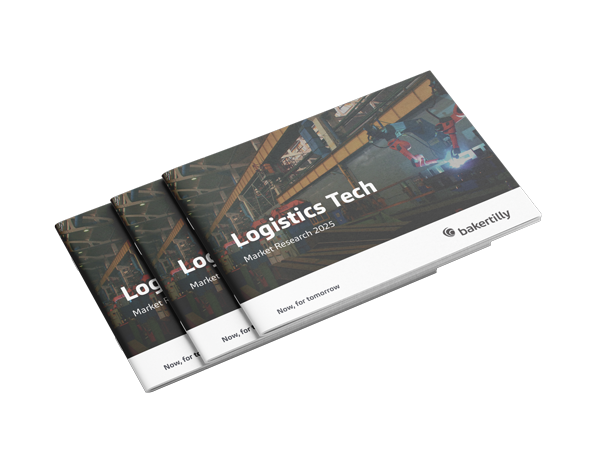In a world where immediacy is no longer a luxury but an expectation, logistics has become one of the most powerful levers to gain competitiveness. And if there is one sector that is undergoing an accelerated transformation, it is logistics technology or Logistic Tech.
At Baker Tilly Tech M&A, we have prepared a comprehensive report analyzing more than 28,000 companies in the sector, 1,000 acquisitions and $139 billion in cumulative financing to identify the patterns, challenges and opportunities that are shaping the new competitive map.
Below, we share five key trends that we have extracted from the document. They are just a sample of the in-depth analysis you will find in the Logistics Tech sector report, now available for free download.
Artificial Intelligence and Automation: the new backbone of the industry
The adoption of AI and Machine Learning based technologies is not only improving operational efficiency, but they are redefining traditional roles within the supply chain. We talk about:
- Dynamic route planning systems
- Demand prediction algorithms
- Autonomous robotics for picking, sorting and packaging
This change is not optional: companies that integrate these solutions significantly improve their operating margins and reduce human errors. It’s no coincidence that giants like Amazon and Relay are investing millions of dollars in custom AI models to optimize their logistics.
The report highlights that the “Warehouse Automation & Robotics” segment is undergoing rapid expansion, driven by e-commerce and *just-in-time* inventory models. Companies like Locus Robotics and AutoStore are leading this revolution.
Blockchain and IoT: full end-to-end visibility
In an ecosystem as fragmented and global as the logistics industry, transparency and traceability are strategic assets. The report highlights how technologies such as blockchain and IoT are gaining prominence for their ability to:
- Guarantee the authenticity of the goods
- Preventing fraud and customs errors
- Improve real-time risk management
The incorporation of connected sensors allows the status and location of a shipment to be known at all times, while smart contracts eliminate friction in payment and verification processes.
In our analysis, it is noteworthy how the “Smart Supply Chain Visibility” category is growing rapidly, thanks to the use of IoT for traceability and blockchain for certification. Companies like FourKites and Project44 are leading the way.
Autonomous vehicles and drones: the (already present) future of delivery
Although it may have sounded like science fiction a few years ago, autonomous vehicles and drones are now an operational reality. And we're not just talking about pilot tests—companies like Kodiak Robotics are already deploying autonomous trucks on intercity routes.
At the same time, Zipline's drones are transforming urgent deliveries in remote areas, especially in the healthcare sector.
Some of the advantages of using autonomous vehicles and/or drones in the logistics sector include:
- Last mile labor cost reduction
- Faster deliveries in congested or difficult-to-access areas
- Increased resilience to driver shortages
Emerging markets represent a valuable opportunity for the adoption of these models, as their limited traditional infrastructures create fertile ground for their implementation.
Sustainable logistics: from a “nice to have” to a “must”
Sustainability has shifted from being a marketing argument to becoming a regulatory and market requirement. The report highlights how the pressure to reduce emissions is driving a wave of “green” innovation:
- Fleet electrification
- Route optimization to reduce consumption
- Reusable and plastic-free packaging
In this regard, the “Sustainable Logistics Technology” segment stands out, including companies like Einride (electric freight vehicles) and Zedify (zero-emission last-mile deliveries).
In addition, many corporations are integrating ESG KPIs into their logistics strategies, which opens a window of opportunity for startups specializing in carbon traceability and energy efficiency.
E-commerce and D2C models: the great catalyst for logistics innovation
The rise of e-commerce has not only multiplied the volume of shipments, but has also radically changed consumer requirements:
- Same day delivery
- Full order visibility
- Fast and automated returns
This has forced logistics companies to adapt their infrastructures and processes quickly, driving growth in segments such as:
- “E-Commerce Logistics”: platforms such as Veho and ShipRocket
- “Parcel Delivery Tech”: where solutions such as Paack and Stuart are emerging Fetch or Gojek
- “Micro-fulfillment centers" and automated urban hubs
Conclusion and report download
E-commerce is emerging as the main driver of the digital logistics revolution. Companies that prioritize strategic investments in the flexibility and scalability of their logistics operations not only capture greater market share but also radically transform the end-customer experience. The leading organizations in 2025 are those that have effectively integrated automation, artificial intelligence, and IoT solutions into their supply chains. Far from being mere operational optimizations, these technologies represent decisive competitive advantages in an environment where immediacy and personalization are standard consumer expectations.
If you're part of the logistics ecosystem—whether as an operator, investor, technology provider, or advisor—you can't afford to miss this report. Inside, you'll find a detailed subsegment analysis, from Freight Tech to Relocation Aggregators, as well as a global mapping of leading and emerging players, along with several practical recommendations for investors, corporations, and startups.
At Baker Tilly, we remain committed to guiding organizations through this strategic transition, identifying growth opportunities and mergers that maximize value in the dynamic logistics technology sector.
Logistics Tech Industry Sector Report 2025
Download here the complete report and stay informed about M&A activity and the latest news from the most important companies in the market.

